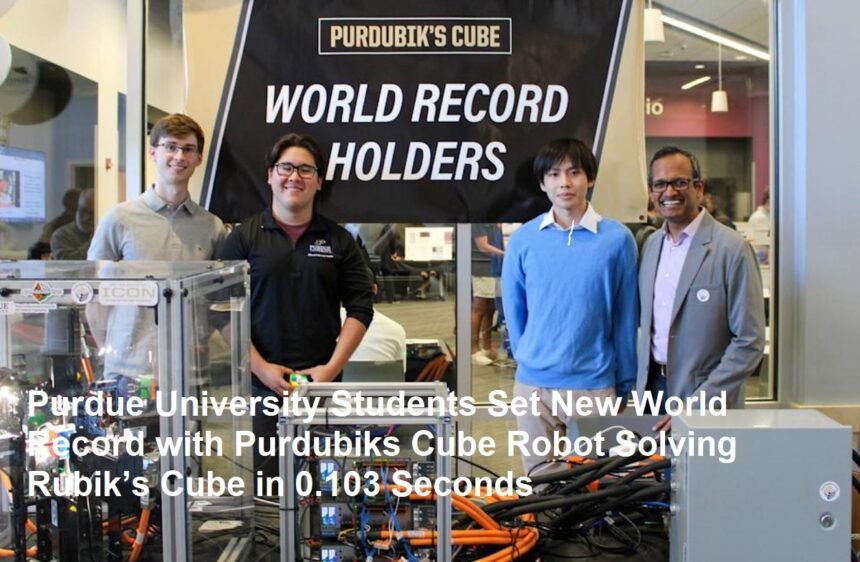In a remarkable feat of engineering and robotics, a team of students from Purdue University has shattered the world record for the fastest Rubik’s Cube solving robot. Their creation, named the Purdubiks Cube, achieved an astonishing solution time of just 0.103 seconds (103 milliseconds), significantly surpassing the previous record of 0.305 seconds (305 milliseconds) set in 2024 by a robot developed by the Mitsubishi Electric Corporation’s Production Engineering Center.
The Purdubiks Cube robot represents a breakthrough in speed, precision, and mechanical design. The Purdue team combined advanced computer vision, rapid processing algorithms, and ultra-fast mechanical actuators to create a system capable of analyzing and solving the Rubik’s Cube puzzle in a fraction of a second. This achievement not only demonstrates the potential of robotics in solving complex problems quickly but also highlights the innovative spirit and technical expertise of the students involved.
The previous record, held by Mitsubishi Electric’s robot, was already an impressive milestone in robotic dexterity and speed. Their robot solved the Rubik’s Cube in 0.305 seconds, a time that seemed almost unbeatable given the mechanical and computational challenges involved. However, the Purdue team’s success in cutting this time down to just over a tenth of a second marks a new era in robotic performance.
Key to the Purdubiks Cube’s success is its sophisticated image recognition system, which instantly scans the cube’s configuration and feeds the data into a high-speed solver algorithm. This algorithm calculates the optimal sequence of moves to solve the puzzle in the shortest possible time. Meanwhile, the robot’s mechanical arms, equipped with precision motors and sensors, execute the moves with incredible speed and accuracy, minimizing any delay between moves.
The engineering challenges in achieving such rapid solving times are considerable. The robot must overcome issues such as mechanical inertia, friction, and the need for precise timing to avoid errors. The Purdue team’s design incorporates lightweight materials and optimized motor control to reduce these physical limitations. Additionally, the software is finely tuned to process visual data and compute solutions almost instantaneously.
Beyond the technical marvel, the Purdubiks Cube project serves as an educational platform for students to apply theoretical knowledge in real-world robotics applications. It fosters interdisciplinary collaboration among students specializing in computer science, mechanical engineering, electrical engineering, and artificial intelligence. The project also inspires innovation and problem-solving skills that are essential in today’s rapidly evolving technological landscape.
The implications of this achievement extend beyond the realm of competitive Rubik’s Cube solving. The technologies developed for the Purdubiks Cube—such as rapid image processing, real-time decision-making algorithms, and high-speed mechanical actuation—have potential applications in various fields. These include manufacturing automation, robotic surgery, autonomous vehicles, and any domain requiring fast and precise robotic manipulation.
Moreover, the record-breaking performance of the Purdubiks Cube robot highlights the accelerating pace of advancements in robotics. As computational power increases and mechanical designs become more refined, robots are increasingly capable of performing tasks that require both speed and precision. This progress opens new possibilities for integrating robots into everyday life and industry.
The Purdue team’s accomplishment has garnered attention from the global robotics community and media, celebrating the ingenuity and dedication behind the project. It also sets a new benchmark for future teams and companies aiming to push the boundaries of robotic capabilities.
In conclusion, the Purdue University students’ creation of the Purdubiks Cube robot, which solved a Rubik’s Cube in an unprecedented 0.103 seconds, marks a significant milestone in robotics and engineering. By surpassing the previous record by more than two-thirds, the team has demonstrated the power of innovation, collaboration, and cutting-edge technology. As robotics continues to evolve, achievements like this inspire new generations of engineers and researchers to explore the limits of what machines can accomplish.









